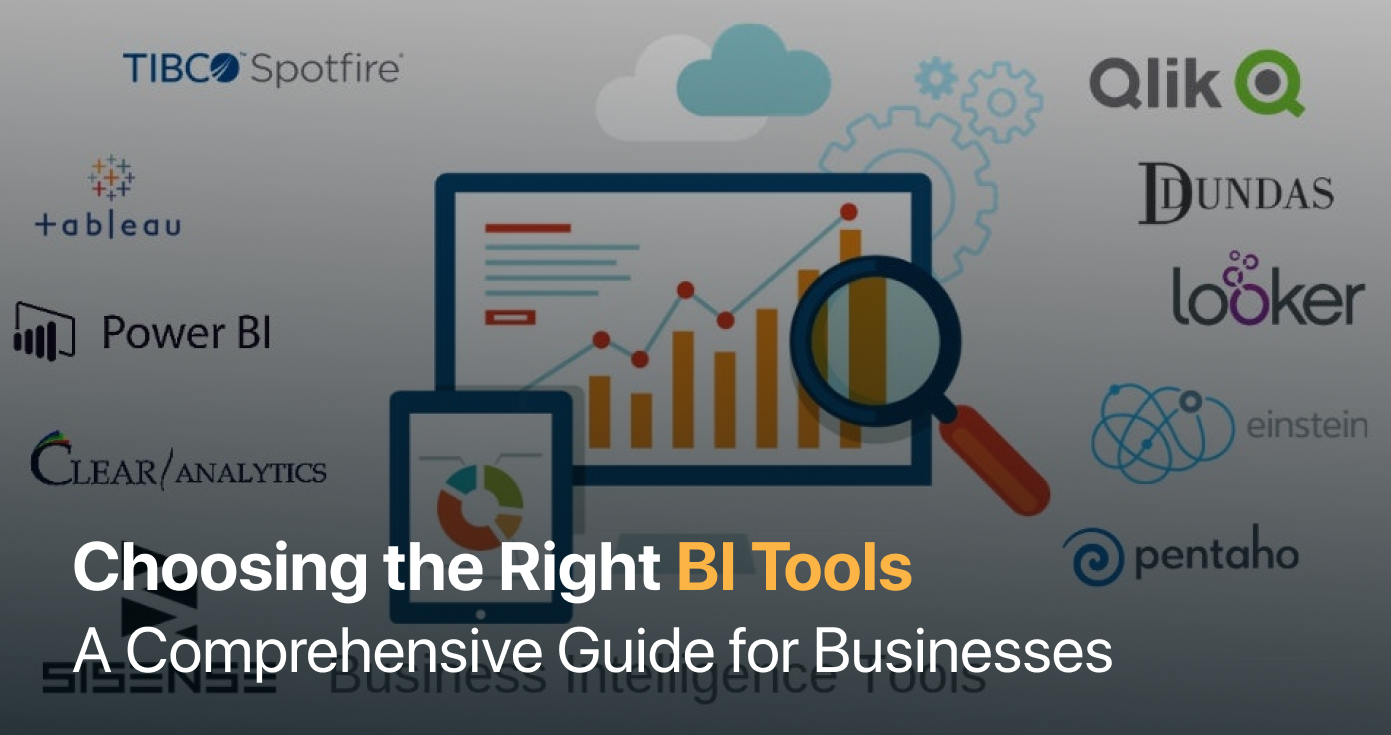
Choosing the Right BI Tools: A Comprehensive Guide for Businesses
According to research, The average organization uses four or more different business intelligence solutions, making the global adoption rate of business intelligence 26%.
In today’s world, there are oceans of data available for any business to dip into. By engaging customers, interacting with stakeholders, suppliers, etc., and performing various operations within and outside organizations, the amount of information in existence has greatly increased, and it continues to do so. However, amidst this abundance lies a challenge: the question of how such data can be best utilized by businesses with the aim of strengthening some of their crucial decision-making aspects and gaining a competitive advantage.
Here come the Business Intelligence (BI) software tools—the compasses and the maps—of the world of data. These robust software applications enable companies to gather and process data and present it in a format where clear strategic advantages are discernible. However, choosing from a wide range of BI tools can overwhelm a beginner.
Therefore, this article offers both a beginner’s and a comprehensive guide for businesses on how to choose the right BI tools.
What is Business Intelligence?
As per statistics, It is anticipated that the market for business intelligence will expand from $29.42 billion in 2023 to $54.27 billion by 2030.
Business Intelligence (BI) is a set of technologies, applications and tools that are used to support the gathering of information, analysis and reporting of the data collected by the company’s business units. Business intelligence is therefore the utilization of particular software instruments and methods by which huge piles of unstructured data are collected, sorted, and analyzed with a view of informing strategic organizational decision making that leads to business evolution and enhanced competitiveness.
BI comprises processes like data warehousing, data mining, data visualization tools like reports and dashboards, and assessing predictive analytics to establish relations and patterns in the data. Thus, use of BI helps businesses manage and improve the effectiveness of operations, recognize and capitalize on potential opportunities, and minimize potential threats in departments and various organizational units.
The purpose of BI is to deliver correct, timely and relevant data to the decision-makers in the organization so as to support them realize the intended objectives. BI is mostly used to combine sources of data within an organization, and/or external databases and applications, to give an overall view of the business environment. In conclusion, BI enables organizations to open up a competitive advantage due to the fact that they make statistics and other factual information to be used for enhancement, productivity as well as enhancement of profitability.
A Beginner’s Guide for Choosing the Right BI Tool: 10 Tell-Tale Features to Look Out for!
Selecting the proper business intelligence (BI) software tools for your enterprise is a vital determinative factor that influences the potential of your organization for data-driven decision-making. Here’s a step-by-step guide to help you navigate the process:
1. Define your business goals and objectives:
Firstly, writing a business plan does not have to be complicated, although it has to be concise and to the point; therefore, ensure that you start with business goals and objectives. BI software tools will help you draw conclusions and make the right decisions, optimize business processes, get to know your customers better, or achieve several of these objectives at once—define your goals beforehand. Your goals will determine the stations that are efficient for your business and help to organize tasks in accordance with the general business plan.
2. Assess Your Data Needs:
Evaluate your current data requirements and needs to avoid struggling in the data management process. For such identification, you have to determine whether you work with structured, unstructured, or semi-structured data, the amount of data you process, and how frequently it is updated. Think of the nature of the information available and some of the key kinds of data repositories, such as databases, spreadsheets, cloud services, social media, and IoT gadgets.
3. Evaluate Your Technical Requirements:
Check your data handling needs and measures, such as data capacity, compatibility with other applications, security measures, and legal requirements. Discover the capacity of the current BI software tools and the amount and type of data your business may generate in the future. Consequently, the ability to integrate with existing systems and compatibility with the infrastructure of your IT spaces are additionally big concerns.
4. Consider User Experience and Accessibility:
Some of the specific interface characteristics to look for are easy-to-use, understandable, and convenient interfaces. Take into account the audience you are targeting for B2B usage, the reflexivity of certain aspects of big data to their profession, and their overall tech- savvy. It must be compatible with multiple formats, such as desktop, mobile, and web-based platforms, to increase the adoption rate.
5. Evaluate analytical capabilities:
Evaluate the efficacy of the BI tools in regards to their analysis, such as conventional and real-time reporting, the creation of business dashboards, ad-hoc analysis, allowing visualization of information, and predictive analysis. When choosing the sales tools, consider the tools that offer features of analytics such as machine learning, natural language processing, and artificial intelligence, depending on the type of business you are in.
6. Review vendor reputation and support:
BI software tool vendors’ reputations should also be investigated and their utilization experiences analyzed. One should identify customer opinions about them, success stories, and data about similar organizations as a means of measuring their effectiveness and customers’ satisfaction levels. Assess the support that the vendor offers in regards to the products or services being purchased for training and technical support and the documentation that they will provide during the implementation phase as well as during the usage period.
7. Consider the Total Cost of Ownership (TCO):
Look at BI tool costs by quantifying and comparing the total cost of ownership (TCO) of each option, including buying the license, implementation costs, yearly maintenance and support, etc. Some issues can therefore be evaluated based on plan viability and scalability, as well as specific customization requisites and possible concealed expenditures.
8. Pilot and test the BI Software tools:
Finally, perform evaluation and pilot tests or proof-of-concept BI tools that have been chosen for a specific setting to determine how effectively they perform in practice. Integrate stakeholders and users to examine the acceptability and satisfaction levels of the products in their intended setting. He highlighted the need to evaluate the usability, functionality, and performance of the various tools ahead of making the final decision.
9. Plan for Implementation and Adoption:
After a thorough evaluation and selection of a BI tool, create an implementation strategy that outlines details such as timelines, milestones, and resources needed for the implementation of the selected BI tool. Ensure you invest time with end-users to make the tool useful to them, and make sure everyone in your organization gets value from it.
10. Monitor and iterate:
The last one is to follow and track the application and effectiveness of the BI tool, as well as its reception by users and interested parties. Function: Determine where your future BI efforts may be lacking or can be refined, and adjust your BI plan going forward to match the company’s ever-changing goals and objectives.
When assessing BI software tools and applying all the steps involved, along with aspects of business goals, data requirements, technical infrastructure, and end-user preferences, the appropriate BI tools are identified that will enable the organization to harness data for maximum benefits.
Conclusion:
Choosing the proper BI software tools is a strategy that should be strictly followed by any company that wants to be successful in the modern conditions of the struggle for market share in the world-wide market. From the detailed description provided in this BI system selection guide, we have learned that the selection of BI tools involves the examination of different factors like the business objective, the nature of data and requirements, usability, the BI vendor, and the cost of ownership, among others.
It is through establishing organizational business objectives, analyzing data necessities, and reviewing technical resource capacities that the proper BI software tools can be determined by an organization. Crucial is the availability and usability of the tool in order to establish widespread implementation and thus increase the penetration of the tool throughout the company.





